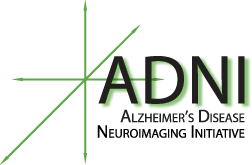Participant Pool:
- 135-500 Normal Controls (new)
- 295-330 Normal Controls (rollover from ADNI2; approximate)
- 150-515 Mild Cognitive Impairment (MCI) (new)
- 275-320 Mild Cognitive Impairment (MCI) (rollover from ADNI2; approximate)
- 85-185 Mild Alzheimer’s Disease dementia (AD) (new)
- 130-150 Mild Alzheimer’s Disease dementia (AD) (rollover from ADNI2; approximate)
Objectives:
- Longitudinal changes in cognition and associated biomarkers
Determine and define those measures of cognition and function, including composite measures, and those biomarker measures, which capture longitudinal change with the highest statistical power to detect treatment effects in clinical trials. Longitudinal change of cerebral tau measured with 18F-AV-1451 PET (AV-1451) will be correlated/compared with other measures.
- Prediction of cognitive decline
Determine which clinical, cognitive, and biomarker measures that best predict decline of cognition in CN, MCI, and AD participants. In addition, determine which biomarker changes correlate with cognitive decline, with focus on AV-1451 PET.
- Validation
Validate biomarker measures obtained at Baseline and longitudinally by correlating results with ‘gold standard’ clinical measurements and pathology.
- Clinical trial design
Determine the optimum outcome measures with attention to cognitive decline and AV-1451 PET (tau PET) , predictors of cognitive decline, and inclusion/exclusion criteria for clinical trials of cognitively normal participants (for secondary preclinical AD trials), MCI patients (for prodromal AD trials) and participants with early dementia due to AD.
- Discovery
To determine the effects of other known disease proteins found in AD brains and genes, as well as newly discovered genes, proteins, and analytes that provide useful information concerning the pathogenesis/diagnosis of AD.
Further Reading
- The Alzheimer’s Disease Neuroimaging Initiative: Progress report and future plans
- The Alzheimer’s Disease Neuroimaging Initiative: A review of papers published since its inception
- Impact of the Alzheimer’s Disease Neuroimaging Initiative, 2004 to 2014.
- The Alzheimer’s Disease Neuroimaging Initiative 3: Continued innovation for clinical trial improvement


